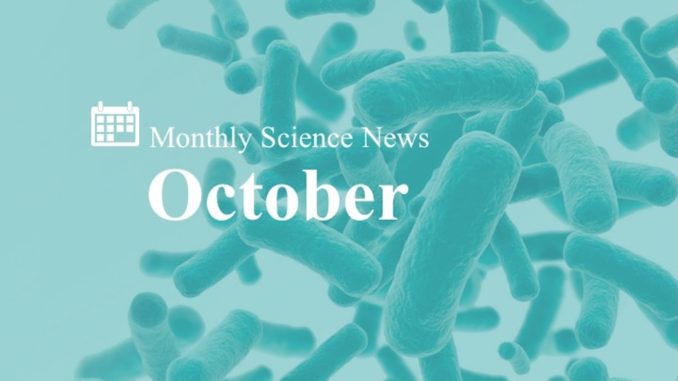
Below are October’s must-read scientific papers on the microbiome and human health. The first highlighted paper this month expands what we know about viruses, the tiniest members of the gut microbiota, which are often eclipsed by the more popular (and frequently-studied) bacterial members. Then comes an article that advances knowledge about how delivery mode affects gut microbiota in the first year of life, with a slight hint about what it could mean for the health of the child.
The next three papers focus on a hot area within microbiome research—gut microbiota and diet: (1) a deep dive (using a mouse model) into how diet sets the stage for the microbiome’s response to an antibiotic perturbation; (2) a study identifying a microbially-linked mechanism (separate from TMAO) by which red meat in the diet may exert health effects; and (3) a somewhat surprising report of how the gut microbiota reacts differently to cooked starch versus raw starch.
October also brought around 400 scientists and microbiome industry leaders together for the 2019 Global Engage Microbiome R&D and Business Collaboration Forum USA in San Diego. From the wide-ranging presentations this year, it is apparent that many organizations are driving forward the application of new tools and approaches. A venture capital panel confirmed there is still a strong interest in microbiome-related medicinal products and platforms; yet some investors appear to be awaiting the ‘foundational’ Phase 2 clinical trial results that will set the direction for the industry in the coming years. See the Twitter hashtag #MicrobiomeSeries for highlights of selected talks at this event.
The Human Gut Virome Is Highly Diverse, Stable, and Individual Specific
Viruses (that is, predominantly bacteriophages) are important members of the human gut microbiota, but their contributions to the overall microbial community represent a big gap in our understanding. The lab of Prof. Colin Hill is working to help establish our baseline knowledge about the gut virome in healthy individuals. Here, the group surveyed the gut virome in ten people over one year—and paired the information with 16S rRNA gene sequencing data to assess co-occurring bacterial relative abundances. The resulting catalogue of viral sequences included 39,254 non-redundant complete viral genomes, and 97 partial ones. The researchers observed a ‘persistent personal virome’: it was both highly individual, and remarkably stable over the period of a year. Moreover, particular bacteriophages correlated with the dominant gut bacterial taxa, well-known to researchers: Bacteroides, Prevotella and Faecalibacterium.
Impact of delivery mode-associated gut microbiota dynamics on health in the first year of life
These are still open questions about early life: how does delivery mode affect the infant gut microbiota, and how is this linked to the health of the growing child? The results of previous landmark studies that compared the gut microbiota of infants born by vaginal delivery versus those born by Caesarean section (C-section) may have been confounded by maternal antibiotics during labor. But a new study published in Nature Communications addressed this issue through a clever study design that involved clamping the umbilical cord prior to routine administration of maternal antibiotics.
The fecal microbiota of 74 vaginally-born and 46 C-section-born infants was assessed throughout their first year—and as it turned out, compositional differences persisted over this entire period of time. While the health effects of the gut microbiota differences are not entirely known, the researchers did link infants’ microbiota composition at one week with the number of respiratory infections in the first year. The taxa that appeared to drive this prediction were Enterococcus, Bifidobacterium, and Klebsiella.
Microbial Metabolism Modulates Antibiotic Susceptibility within the Murine Gut Microbiome
It’s abundantly clear that antibiotics disrupt the gut microbiome. But in humans, antibiotics have differing effects—in some cases the gut microbiome ‘bounces back’ after a number of weeks while in other cases complete recovery (in terms of composition) never occurs. A new mouse study gets us closer to being able to predict the nature of the gut microbiota perturbations, by exploring how the intestinal metabolic environment contributed to antibiotic susceptibility. The authors showed that specific dietary carbohydrates affected the microbiome’s reaction to antibiotics—that is, the blooming of B. thetaiotaomicron in the presence of amoxicillin. Linked in vitro data showed the response of B. thetaiotaomicronto the antibiotic was enhanced by glucose and reduced by polysaccharides.
Scientists have been looking for mechanisms accounting for the epidemiological link between red meat and negative health outcomes—but it’s been surprisingly difficult to uncover something that’s red-meat-specific. A new study provides evidence from both mice and Hadza people that a mechanism that depends on gut microbes appears to influence the health effects of red meat. The experiments showed that gut bacteria use enzymes to cleave off a non-human sugar (or ‘glycan’, called Neu5Gc) from meat that enters the gut. This turns the sugar into a harmless version that can be excreted in the urine, which prevents the generation of antibodies and inflammation.
Cooking shapes the structure and function of the gut microbiome
Research on diet and the gut microbiota has tended to focus on the impact of various macronutrients—but the lab of Pete Turnbaugh turned to the question of whether the gut microbiota responded differently to raw versus cooked foods. No clear differences marked the gut microbiomes of mice fed raw versus cooked beef. But the differences showed up when it came to starch-rich foods: sweet potato, white potato, corn, peas, carrots, and beets. In both mice and humans, the cooked foods had different effects on the gut microbiota than the raw versions. It appeared that the act of cooking the plants was important for shaping the gut microbiota and had potentially positive effects,improving starch digestibility in the host.


